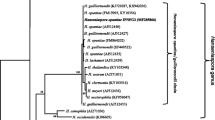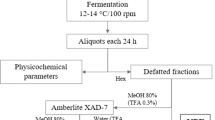Abstract
Monacolins, well-known natural statins obtained from rice fermentation with Monascus purpureus (red yeast), are a class of fungal secondary metabolites able to inhibit HMG-CoA reductase. Interest in using fermented products as natural sources of monacolins, instead of chemically synthesized statins, has increased enormously in recent years mainly because these substances are perceived as ‘natural’. This perception has also increased the demand for them. In this study we first analyzed the composition of several Chinese red yeast-fermented dried extracts commonly available on the market. Fifht percent of them (16 out of 32) did result to be likely adulterated products whilst the other 50% did not. Anyway, the not adulterated products did show 1) high variability in terms monacolin K and KA (considered to be the active monacolins), 2) relevant content in terms of inactive, or poorly active, secondary monacolins, 3) detectable content in terms of citrinin, a nephrotoxic compound and secondary metabolite yealded by fermentation process and 4) a total titre, expressed as monacolin K, correspondent instead to the sum of all monacolins present in the extract. We have therefore developed a method for purifying not adulterated red yeast fermented products in order to produce a highly purified, standardized extract (MonaKoPure-K20) characterized by a constant, high content of monacolin K+KA (≥20%), no detectable citrinin (<50 ppb) and very few secondary monacolins, where the global titre, expressed as monacolin K, exactly corresponds to the combined content of the two monacolins K and KA.
Similar content being viewed by others
References
Hilgendorf I, Swirski FK, Robbins CS (2015) Monocyte fate in atherosclerosis. Arterioscler Thromb Vasc Biol 35(2):272–279
De Paoli F, Staels B, Chinetti-Gbaguidi G (2014) Macrophage phenotypes and their modulation in atherosclerosis. Circ J 78(8):1775–1781
Kita T, Kume N, Minami M, Hayashida K, Murayama T, Sano H, Moriwaki H, Kataoka H, Nishi E, Horiuchi H, Arai H, Yokode M (2001) Role of oxidized LDL in atherosclerosis. Ann N Y Acad Sci 947:199–205
Patel KM, Strong A, Tohyama J, Jin X, Morales CR, Billheimer J, Millar J, Kruth H, Rader DJ (2015) Macrophage sortilin promotes LDL uptake, foam cell formation, and atherosclerosis. Circ Res 116(5):789–796
Hamilton-Craig I, Colquhoun D, Kostner K, Woodhouse S, d’Emden M (2015) Lipid-modifying therapy in the elderly. Vasc Health Risk Manag 11:251–263
Reiner Ž (2015) Management of patients with familial hypercholesterolaemia. Nat Rev Cardiol. doi: 10.1038/nrcardio.2015.92
Kwak HB (2014) Statin-induced myopathy in skeletal muscle: the role of exercise. J Lifestyle Med 4(2):71–79
Sathasivam S, Lecky B (2008) Statin induced myopathy. BMJ 337:a2286
Huang HN, Hua YY, Bao GR, Xie LH (2006) The quantification of monacolin K in some red yeast rice from Fujian province and the comparison of the other product. Chem Pharm Bull (Tokyo) 54(5):687–689
Gordon RY, Cooperman T, Obermeyer W, Becker DJ (2010) Marked variability of monacolin levels in commercial red yeast rice products: buyer beware! Arch Intern Med 170(19): 1722–1727
Zhu L, Yau LF, Lu JG, Zhu GY, Wang JR, Han QB, Hsiao WL, Jiang ZH (2012) Cytotoxic dehydromonacolins from red yeast rice. J Agric Food Chem 60(4):934–939
Gordon RY, Becker DJ (2011) The role of red yeast rice for the physician. Curr Atheroscler Rep 13(1):73–80
Prasad GV, Wong T, Meliton G, Bhaloo S (2002) Rhabdomyolysis due to red yeast rice (Monascus purpureus) in a renal transplant recipient. Transplantation 74(8):1200–1201
Halbert SC, French B, Gordon RY, Farrar JT, Schmitz K, Morris PB, Thompson PD, Becker DJ (2010) Tolerability of red yeast rice (2,400 mg twice daily) versus pravastatin (20 mg twice daily) in patients with previous statin intolerance. Am J Cardiol 105(2):198–204
Kuncl RW (2009) Agents and mechanisms of toxic myopathy. Curr Opin Neurol 22(5):506–515
Klimek M, Wang S, Ogunkanmi A (2009) Safety and efficacy of red yeast rice (Monascus purpureus) as an alternative therapy for hyperlipidemia. P T 34(6):313–327
Lin YL, Wang TH, Lee MH, Su NW (2008) Biologically active components and nutraceuticals in the Monascus-fermented rice: a review. Appl Microbiol Biotechnol 77(5):965–973
Flajs D, Peraica M (2009) Toxicological properties of citrinin. Arh Hig Rada Toksikol 60(4):457–464
European Union Guideline No. 212/2014. Commission held on March 6th, 2014. Official Report (EU): L 67/3IT. L 67/3-4
Huertas-Pérez JF, Arroyo-Manzanares N, García-Campaña AM, Gámiz-Gracia L (2015) High-throughput determination of citrinin in rice by ultra-high-performance liquid chromatography and fluorescence detection (UHPLC-FL). Food Addit Contam Part A Chem Anal Control Expo Risk Assess 32(8):1–6
Author information
Authors and Affiliations
Corresponding author
Rights and permissions
About this article
Cite this article
Nannoni, G., Alì, A. & Di Pierro, F. Development of a new highly standardized and granulated extract from Monascus purpureus with a high content of monacolin K and KA and free of inactive secondary monacolins and citrinin. Nutrafoods 14, 197–205 (2015). https://doi.org/10.1007/s13749-015-0047-4
Received:
Accepted:
Published:
Issue Date:
DOI: https://doi.org/10.1007/s13749-015-0047-4




